February 26, 2008
Self Portraits in Glass
32 fused glass artists all doing self-portraits.
Self Portraits in Glass '06 and now, Self Portraits '08
Nice idea. Wildly diverse in quality but always nice to see another 'variations on a theme' project. It would be interesting to see the same thing happen with stained/painted glass artists.
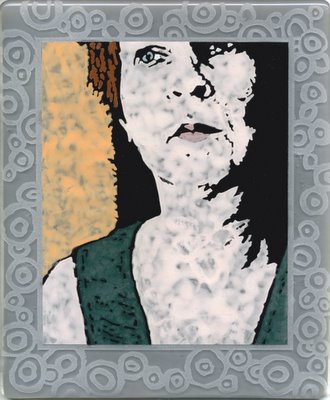
self portrait by Cynthia Oliver, who was one of the main organizers of the project.
February 21, 2008
Requiem for a Stained Glass Window
Just today, news from this AP article (and picked up by many sites like USA Today) announcing that the demolition of the Robert Sowers JFK Airport Window was started last week, ending in failure a long effort to save what was in its time believed to be the largest single stained glass window in the world.
You get a little more info at the rescue website called Save America's Window.
Curiously, I could find no other pictures than this on the web.
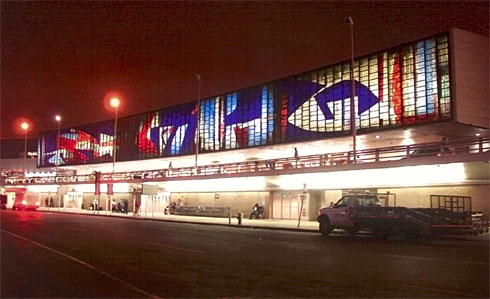
Sad, but not surprising, conclusion. We live in the age of planned obsolescence, or in this case, not-well-planned obsolesence. As much as the artistic and historical significance was acknowledged, the prevailing factors were space and money - too big and too costly to move as a whole. Plus, let's be honest, Robert Sowers is not exactly a household name. Well known within the world of stained glass to be sure, but not a mass market iconic name.
It's ironic that Ken VanRoenn is the one quoted in the initial AP article, since he is the first stained glass artist/architect I ever heard use the term 'economic life of a building', in a keynote address at a SGAA conference in 1992. He was making the point that stained glass studios, if they hoped to market their work in commercial, office or public buildings, would need to deal with the fact that the average economic life of a building is 35 years. I remember it sent chills down my spine, since this notion is not conducive to the traditional idea of stained glass, where the artwork is created for the ages, not the next 35 years.
I suppose there's some lesson I'm supposed to take away from this - vanity of vanities, all is vanity, etc, etc, blah, blah blah.
In any case, just do the best work you can and hope for the best.
[update feb 22, 2008 - New York Times article including pictures of workers dismantling the window. painful.]
February 13, 2008
Millenium Windows in the UK
In the 8 years since passing into the 21st century, I seem to have missed the phenomenon of the "Millenium Window".
This is something that appears to have happened (mostly) in British Commonwealth countries from around the years 1997-2004. No substantial equivalent happened in the USA or anywhere else as far as I can tell.
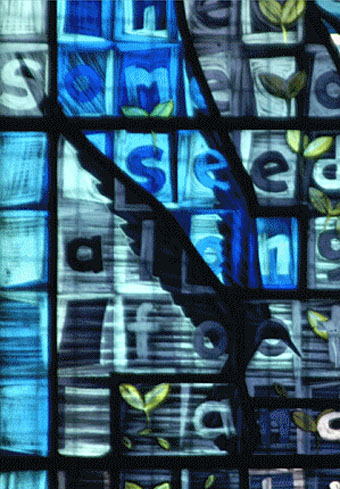
detail, Millenium Window, Glasgow Cathedral, Glasgow, Scotland. by John K Clarke - 2001
I've gathered images and info on more than a dozen Millenium Window commissions throughout the UK.
Background
The only item I found mentioning the building of things 'Millenium' is in this article called The UK Millenium Construction Boom, which mostly describes money poorly spent when funded by the Millenium Fund, an arts lottery funding project in the UK. If you go to the bottom of the page, there is a list of 10 successful (according to the journalist) Millenium commissions, including the most famous one, the London Eye, also known as the Millenium Wheel.
In looking at specific stained glass window 'Millenium' commissions, there don't appear to be any thematic similarities between the different commissions, and stylistically they are quite diverse. Yet they are all 'Millenium' windows. Some were definitely funded by a 'Millenium fund' of some sort, but others were not.
St. Paul's Church Millenium Window
I came across my first Millenium window while browsing through a Flickr set by building fan
Millenium Window, in St. Paul's Church, Birmingham, England. Made by Rachel Thomas of Holy Well Glass in Somerset.
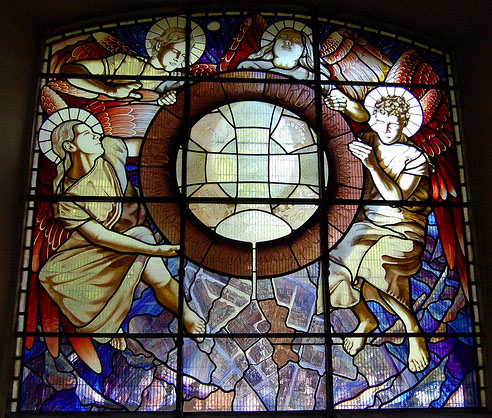
There is a little more info on Rachel Thomas from the 'award winners' page of The Worshipful Company of Glaziers and Painters of Glass website.
What caught my eye in this window is the vantage point - it's a 'Heaven's eye view', sort of the reverse of an Italianate Trompe l'oeil Ceiling . So the viewer is looking down at the angels toward the distant ground below, as seen in this detail. An interesting perspective, and one I've never seen before in stained glass.
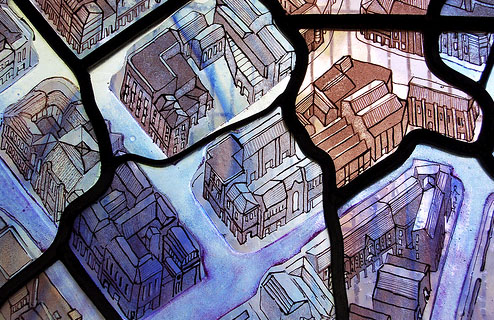
another detail - again via building fan
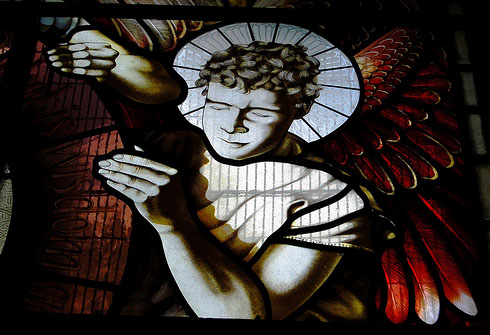
And this image is from the 'Worshipful Company' site...
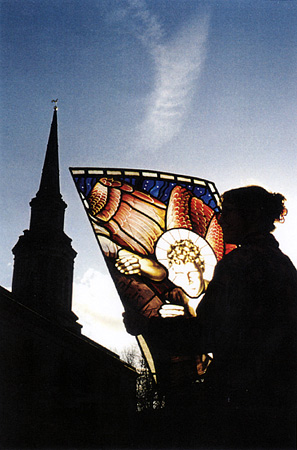
In any case, in searching for information about this commission I started coming across other Millenium Windows that were every bit as interesting, and all made in the British Commonwealth...
Glasgow Cathedral Millenium Window
I like the work of John K. Clark. I've been to Glasgow and seen his Princes Square Parrots and his fish window at Cafe Gandolfi. I've linked to him before but it has been a long time, and there is lots of new work.
and he did this fascinating Millenium Window For Glasgow Cathedral.
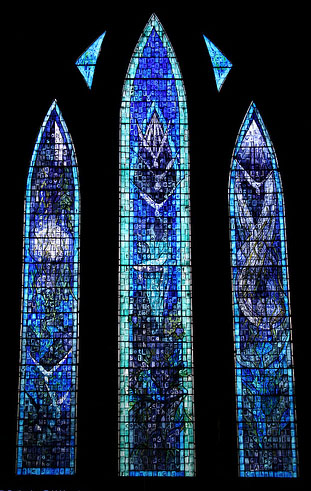
I particularly like his incorporation of text in design, a recurring theme in recent projects.
The Millenium window is a good example of that, though it's only with the closer shot that you see the text at all.
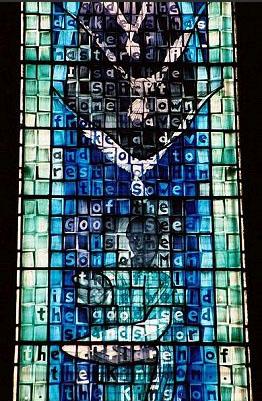
I also like how he plays with the black lines throughout, hiding the leadlines so that it melds together into a kind of undulating field of lines and colors and letter shapes.
Even closer - to see better how the text and image are interwoven.
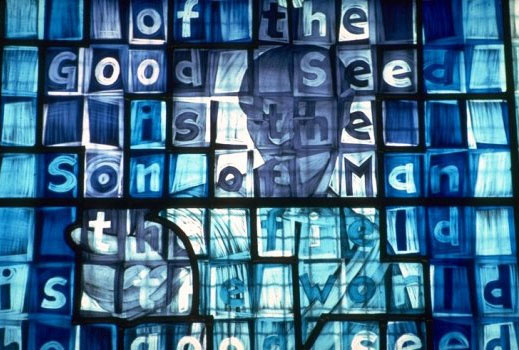
Goodrich Castle Millenium Window
A unique Millenium Window in Goodrich Castle, Hereford, Worcestershire, England.
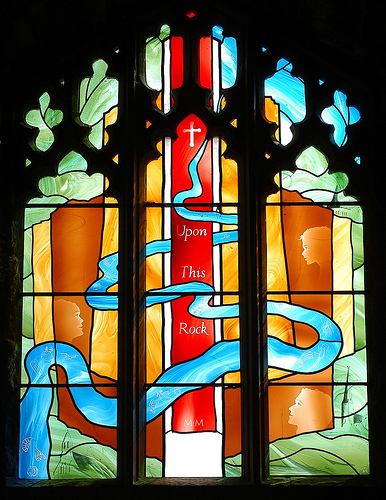
It's odd that there is stained glass at all, especially modern stained glass, seeing that all exterior pictures of the site make it look like a total ruin. but the stained glass is there in the chapel.
This is just one picture from a blogpost by Ian Grey that shows the windows in a clearer context. Exterior shot showing the Millenium window just to the left of the gateway.
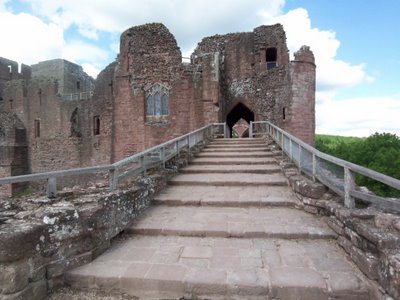
The close-up pictures show the etched detail. This and small painted details go on throughout the window.
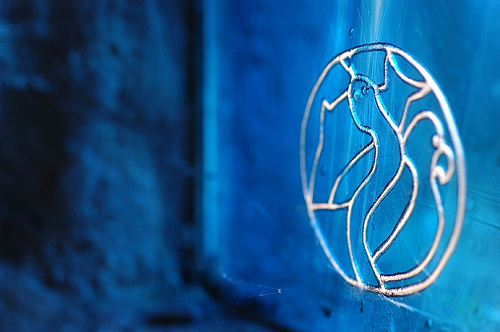
photos from the Stuart Herbert Flickr Set
Busby Parish Church Millenium window
Millenium Window, Busby Parish Church, 2000, Church of Scotland. Design/Fabrication by Cannon-Macinnes, Glasgow, Scotland. Simple and contemporary, with a wee nod to Mackintosh. I know Linda Cannon (the Cannon of Cannon/Macinnes) from when she visited Boston nearly 20 years ago. She's a smart and talented colleague and I'm glad to see her doing such nice work.
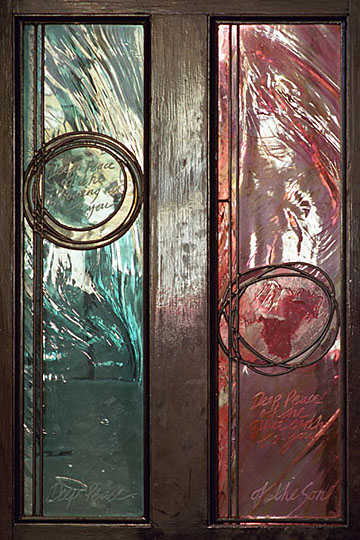
Close up showing the deep acid-etched text. Nice that it's acid-etched and not sandblasted - makes all the difference in a situation like this.
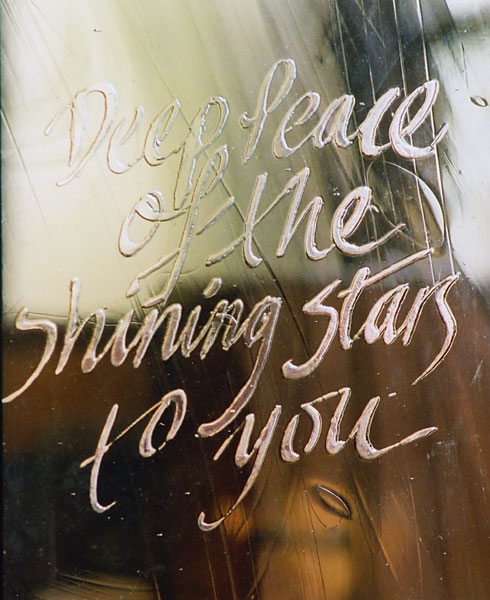
St. Mary's Church Millenium Window
Flickr page by 'TheRevSteve' showing the Millenium Window at St. Mary's Church, Little Abington, Cambridgeshire, England.
full shot
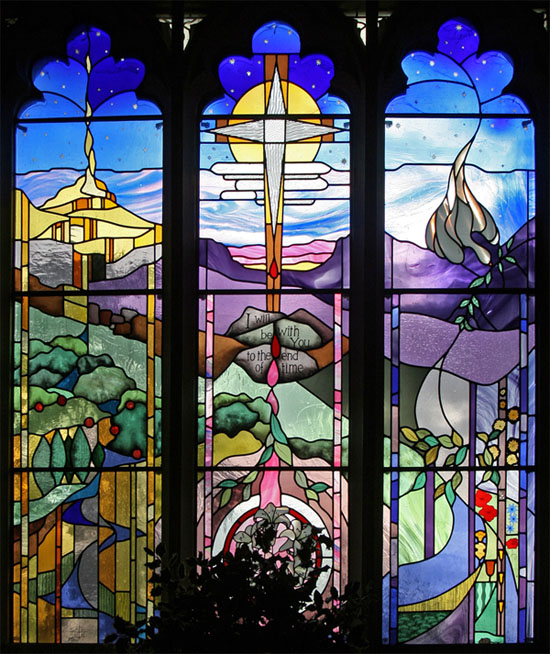
details with center text
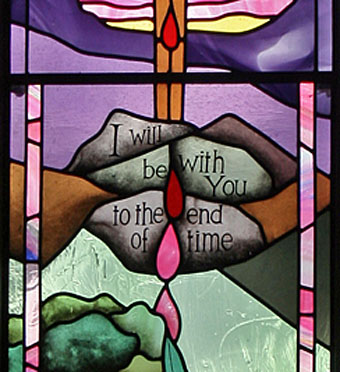
Chester Cathedral Millenium Window
Ros Grimshaw did a Millenium Window (as often referred to as the Creation Window) for Chester Cathedral.
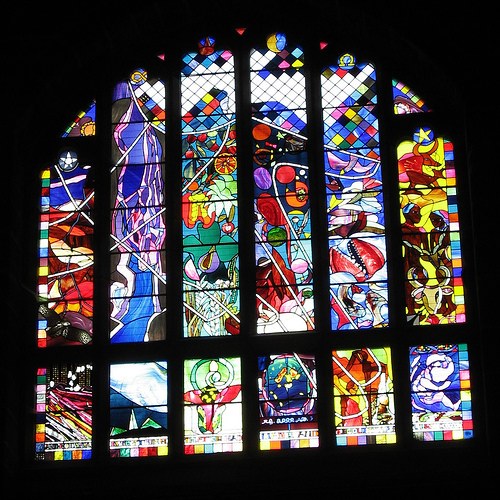
You can listen to a 10 minute BBC Radio program from 2004 on the Chester Cathedral Creation/Millenium Window. Ros Grimshaw has Parkinson's Disease and was working on this window while in hospital. I've seen images of her work in the past that is more geared toward painted design, like this from Saint Augustineís Scaynes Hill, with her windows at the bottom of the page.
Links to more Millenium Windows
Caroline Swash did an abstract Millenium Window for The Godolphine School, in Salisbury, Wiltshire, England.
Mark Cazalet did a Millenium Window, not in stained glass but in etched and engraved clear glass, for Worcester Cathedral.
Rather more conventional pictorial Millenium windows can be seen at St. Peters Church, Boughton, Monchelsea and St Mark's Parish, Dukinfield, Church St., Dukinfield, Cheshire, and another from St. Matthews, Langford, and yet another one, this time designed by the villagers in Towersey, Oxfordshire, with a better view from a Flickr page from 'Ascendingkitty'.
And finally, the most curious. The Millenium Window at St. Lawrence Church, Hatfield. This window has gained a certain notoriety from the inclusion of a tribute to local boy made good Thomas Crapper. Credited, wrongly as it turns out, with inventing the modern day flush toilet, he nevertheless founded a plumbing company, which exists to this day.
On that strange note, onward into the next millenium!
[update - just found a new English Millenium Window only to hear about it because it was destroyed by fire in March of 2008 - The Millenium Window (2000-2008) at St Nicholas's church Radford Semele, Warwickshire.]
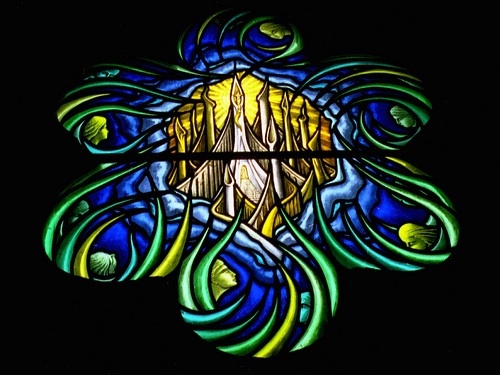
[update - April 29, 2008 - just spotted a new Flickr group devoted to Millenium Windows]
February 08, 2008
York Centre for Stained Glass
It will be interesting to see how this progresses.
An article annnouncing the proposed creation of the York Centre for Stained Glass, at St. Martin-cum-Gregory Church, Micklegate, York, England.
You get a glimpse of the interior of the abandonded church, as it was in January of 2007, in this Flickr set of the Lux Project, a light based exhibit. There is also this video, from the same project.
via the AGG bulletin board
February 03, 2008
McDonald Peace Windows Project
A different 'variations on a peace-themed' window project -
I heard about the McDonald Peace Window project some time ago, but was prompted to research a bit by this new article in the Tacoma News Tribune on the current exhibit at the Washington State History Museum. At first, I only came upon another article, in the Seattle Times. Finally I found the official McDonald Memorial Peace Windows Project website. At the official site, there is information on the overall story of the project and descriptions of the individual panels, as well as information on the artists who worked on the project. Though, oddly, no info on which artists worked on which panels.
The general story, in brief, from that site -
In his war travels, Father McDonald made a habit of stopping at sanctuaries victimized by the conflict. On these visits he picked up broken fragments of stained glass from the rubble. .... For 55 years the glass was kept in a cardboard box... One evening in 1999, three years before Fred McDonald died, he shared the story of the shards with astonished friends around the dinner table.... Till the end of his life, Fredís stories captivated people.... He remembered his interactions with men and women struggling to survive the conflict. As he talked about those meetings, Armelle conceived of a series of windows, each with its own brief story.
This panel is #19, with fragments from Kolner Dome, Germany - also known as Cologne Cathedral, the one that recently dedicated the Gerhard Richter Window.
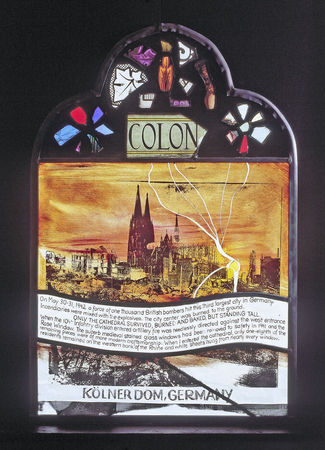
and this is #20, The Russian Chapel, Weisbaden, Germany. A very simple design, yet I like the idea of using the fragments for the figure rather than fitting them inconspicuously into the border or background.
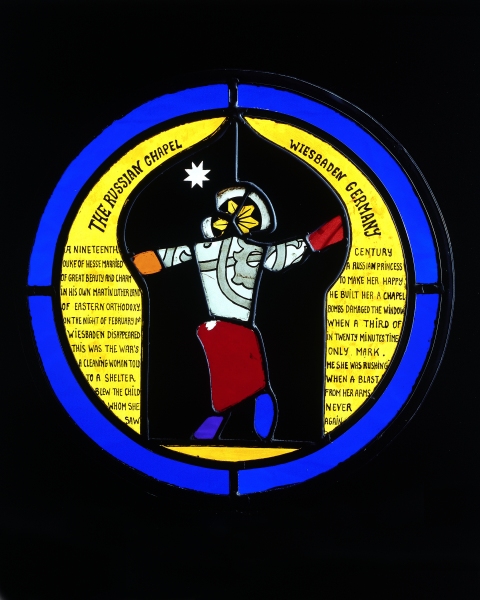
Who, in these turbulent times, cannot sympathize with a work of art that is a plea for peace. I like the idea of using fragments of old panels within contemporary designs. I see it as a kind of dialogue over centuries.
Dialogue is good, and especially important seeing that the theme is peace...
February 01, 2008
I Only Wish it Were Glass
This is a piece of backlit gallery art, utilizing transmitted light just like stained glass, but this is not stained glass - it's brown packing tape on plexiglass, by artist Mark Khaisman.
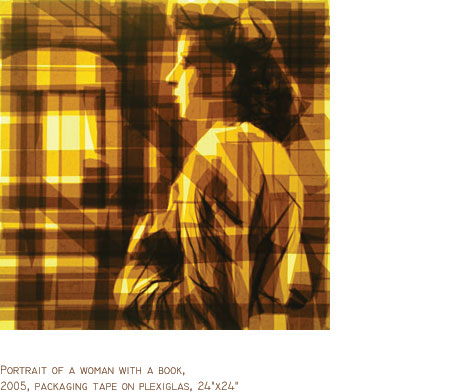
I like the images and I'm kind of fascinated by the process, and I'm always drawn toward light-based art, and I can see where he would like the spontaneity of working in this process. Still, it's packing tape and plexiglass. I can't help but think of the archival implications of using these materials - that is, isn't this likely to simply fall apart in a few years as the adhesive degenerates?
Glass is used for a reason - it lasts.